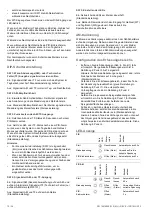
4 / 36
P/N 146169999-10 (ML)
• REV E • ISS 18JUN13
7. For ceiling-
mount applications that require a 90° coverage,
use the SB01 swivel-mount bracket.
Note:
Using the swivel-mount bracket has not been
evaluated by UL/cUL. Ceiling mount application has not
been evaluated by UL/cUL.
8. Close the cover.
9. Insert the screw and place the custom insert.
For EN 50131 Grade 3 installations, do not use mounting
position C (only applicable for AM detectors).
Jumper settings
See Figure 5 for the jumper locations in the detector.
J1: Mode jumper (only available on EV1012AM models)
Note:
Bi-curtain jumper functionality is available in EV1012AM
with firmware version 1.21 or later.
On: BI-curtain mode. In this mode an extra level of processing
is applied to provide enhanced stability in the presence of false
alarm hazards. Bi-curtain is used to reduce the possibility of
false alarms. It looks for signal verification and requires the
intruder to be seen in two curtains.
This mode is not suitable for single curtain applications.
Off: Standard mode (default). This mode is suitable for most of
the wide angle and single curtain applications. The mode must
be used in EN 50131 compliant installations.
J2: PIR enabling the LED
On: Enables the detector LED at all times (default).
Off: Puts the LED under control of the WT (walktest) input. If
the WT input is connected to GND (terminal 1), the red LED
goes on for 3 seconds when a PIR intruder alarm is detected.
If the WT input is connected to +12 V (terminal 2) or floating,
the red LED is disabled.
J3 and J4: Dual loop setting
This sets the alarm and tamper relays. It allows you to connect
the detector to any control panel. Use jumpers 3 and 4. See
Figure 7.
J5: D/N mode (Day/Night) or Rtest (remote test) setting
Use this jumper to set terminal 8 to either D/N or Rtest. UTC
Fire & Security recommends that you use D/N to manage the
AM/TF activation when required. Use Rtest to test the detector
from the control panel. The detector will activate the Alarm
relay if the test result is positive, and the AM relay if the test
result is negative.
On: Terminal 8 = D/N (default).
Off: Terminal 8 = Remote test.
J6: Polarity setting of the control voltage (CV)
On (factory default):
•
The detector is in Day mode (system disarmed) when the
D/N input is connected to GND (terminal 1)
•
The detector is in Night mode (system armed) when the
D/N input is connected to +12 V (terminal 2)
•
The detector is in Walk Test Off mode (LEDs are disabled)
when the WT input is connected to GND (terminal 1)
•
The detector is on Walk Test On mode (LEDs are
enabled) when the WT input is connected to +12 V
(terminal 2)
Off:
•
The detector is in Day mode (system disarmed) when the
D/N input is connected to +12 V (screw terminal 2).
•
The detector is in Night mode (system armed) when the
D/N input is connected to GND (terminal 1).
•
The detector is in Walk Test Off mode (LEDs are disabled)
when the WT input is connected to +12 V (terminal 2).
•
The detector is on Walk Test On mode (LEDs are
enabled) when the WT input is connected to GND
(terminal 1).
D/N and WT functionality
The D/N input:
•
Controls the LED functionality together with the WT input.
•
Resets the alarm memory
•
Controls the AM relay functionality during the NIGHT
mode together with SW1.
The WT input controls the LED functionality together with the
D/N input.
When the detector is in the Day mode and Walk Test On
mode, the LEDs of the detector can be activated. See
“LED
indication
” on page 5 for more information.
During the Night mode the LEDs are always switched off.
If a PIR intruder alarm if detected in the Night mode and the
detector switches back to Day mode, the red LED starts
flashing to indicate an alarm in memory.
The alarm memory is reset by switching the detector to Night
mode.
DIP switch setting
SW 1: When to signal AM (anti-masking) or TF (technical
fault) output
On: Signals AM or TF only when the system is in Day mode
(default). Note that SW 5 must be in the OFF position for this
functionality to be enabled.
Off: Always signals AM or TF during Day and Night mode.
SW 2: AM sensitivity
On: Advanced AM sensitivity. The detector signals the AM
area masking.
Off: Standard AM sensitivity. The detector signals the AM area
approaching (factory default).
SW 3: Resetting the AM/TF output
On: Resets the AM or TF status 40 seconds after a PIR alarm.
Off: Resets the AM or TF status after a PIR alarm when the
system is in Day and Walk Test status. The yellow LED will
blink quickly. When the system is in Night status, the yellow
LED will turn off and the system is reset (default).
Notes
•
For the advanced setting (SW 2 is On) the source of AM
alarm needs to be removed before AM reset is allowed.
•
If the AM alarm cannot be reset with an auto reset or
authorized reset, disconnect the power supply and
reconnect again.
•
A walk test should be performed to ensure the device
settings are appropriate for its application.





































